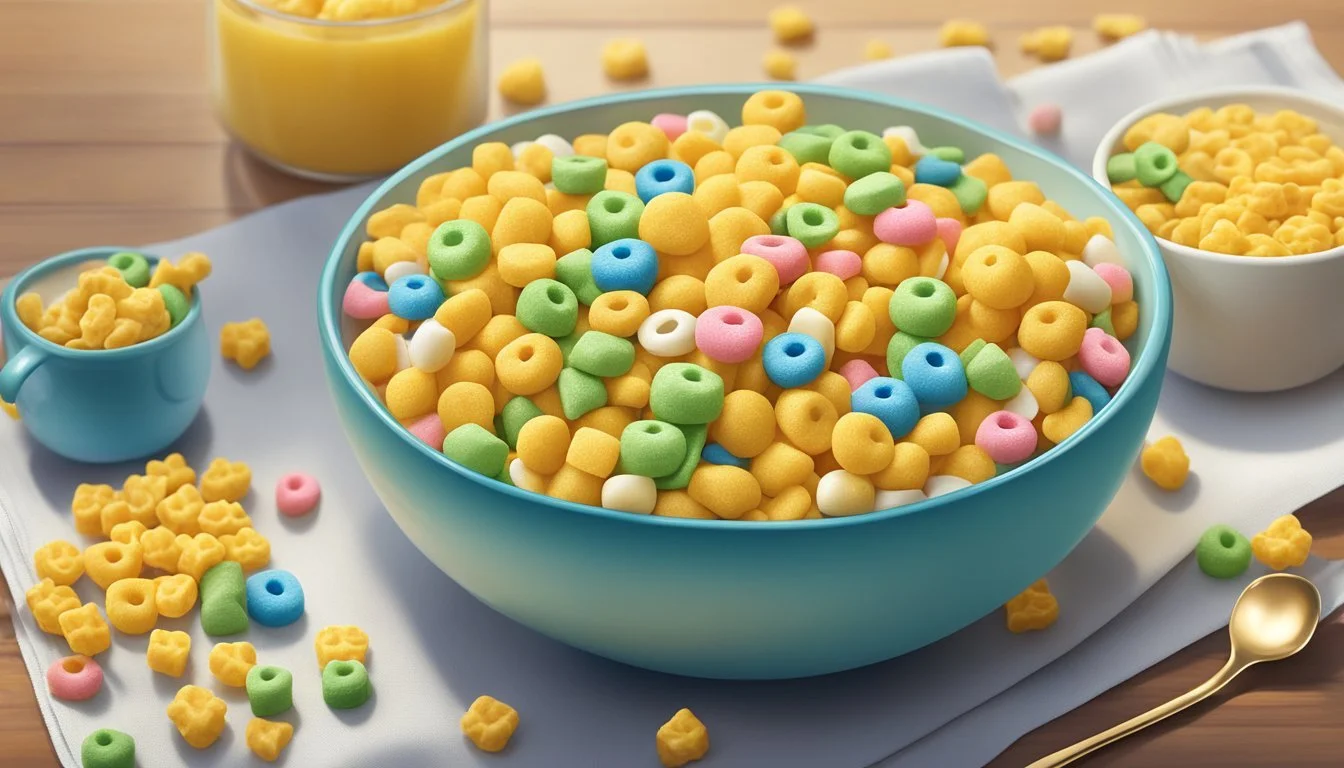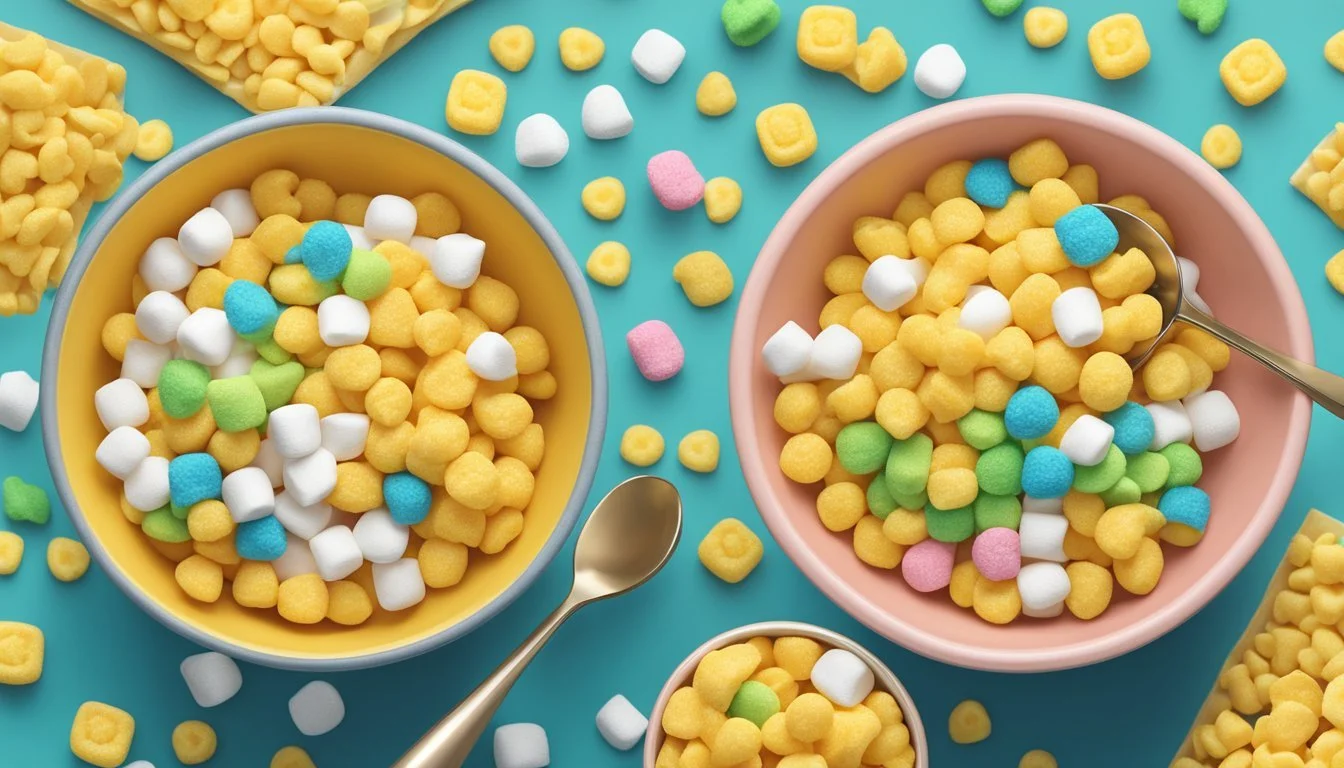Corn Pops vs Lucky Charms
Nutritional Comparison and Taste Test
This Article is Part of Our Breakfast Cereal Guide with Details on Corn Pops Nutrition and Lucky Charms Nutrition
When it comes to breakfast cereals, two popular choices often come to mind: Corn Pops and Lucky Charms. Both cereals have been childhood favorites for many, but the question remains—which is healthier in 2024? Corn Pops offer 13 grams of complex carbohydrates per serving, slightly edging out Lucky Charms, which has 12 grams.
Lucky Charms, on the other hand, surpass Corn Pops in essential vitamins and minerals. Iron, Zinc, and Vitamin B6 are more abundant in Lucky Charms, making it a nutrient-dense option. However, it's worth noting that both cereals are relatively high in sugar and low in fiber.
Consumers should weigh their options based on nutritional needs. Whether one values a higher vitamin intake or a slight edge in complex carbohydrates can be the deciding factor. Both cereals have their pros and cons, making the choice a matter of personal preference.
Historical Background
Corn Pops and Lucky Charms are iconic breakfast cereals that have evolved significantly since their inception. Both have unique origins and have gone through various changes over the decades to become beloved staples in many households.
Origins of Corn Pops
Corn Pops, originally known as Sugar Pops when introduced in 1951 by Kellogg's, aimed to create a sweet and crunchy corn-based cereal. Early advertising emphasized Sugar Pops as both a breakfast food and a snack.
In 1978, the name changed to Sugar Corn Pops to reflect the main ingredients more accurately. By 1984, the cereal rebranded again to Corn Pops, aligning with growing health-conscious trends. Despite these name changes, the core identity of Corn Pops remained the same: a light, sweet corn puff.
Nutritionally, Corn Pops contain a modest amount of protein but are high in sugar. A standard serving, approximately 40 grams, offers around 150 calories. These nutritional aspects have prompted some consumers to moderate their intake.
The Creation of Lucky Charms
Lucky Charms, introduced by General Mills in 1964, innovated by combining oat pieces with colorful marshmallow shapes called marbits. This mix quickly captivated both children and adults.
The original formula didn’t coat the oat bits in sugar until 1967, marking an adaptation to consumer preferences. Over the years, General Mills has introduced numerous limited-edition versions and altered the marbit shapes, such as the inclusion of red, white, and blue stars during the 1996 Summer Olympics.
Lucky Charms’ widespread appeal is largely due to its unique combination of toasted oat cereal and sweet marshmallows, making it a distinctive and attractive breakfast option. Their marketing, featuring the leprechaun mascot, also played a significant role in the cereal's continued success.
Nutritional Value Comparison
When comparing Corn Pops and Lucky Charms, it's critical to examine their caloric content, macronutrients, vitamins, minerals, fiber content, and sugar levels to determine which is a healthier option.
Caloric Content and Macronutrients
Corn Pops and Lucky Charms both contain 110 calories per serving.
Corn Pops provide:
Protein: 1 gram
Fat: 0 grams
In contrast, Lucky Charms offer:
Protein: 2 grams
Fat: 1.8 grams
Monounsaturated Fat: 0.6 grams
Polyunsaturated Fat: 0.5 grams
In terms of carbohydrates, both cereals are relatively similar but should be evaluated closely based on individual dietary needs.
Vitamin and Mineral Content
Lucky Charms are enriched with a higher number of vitamins and minerals compared to Corn Pops:
Iron: 203% more than Corn Pops
Vitamins: A, B1 (Thiamine), B3 (Niacin), B6, B12, Folate, and Calcium
Corn Pops, while still fortified, do not provide the same level of nutritional diversity. Comparing key minerals, Lucky Charms clearly outshine Corn Pops, making it beneficial for those needing additional vitamins and minerals.
Fiber and Whole Grain Analysis
Fiber plays a significant role in digestive health.
Lucky Charms contain 2 grams of dietary fiber, aiding in gut health.
On the other hand, Corn Pops typically contain less dietary fiber, often amounting to less than 1 gram per serving.
Whole grains are generally more abundant in Lucky Charms, which contributes to a richer nutritional profile compared to the mostly refined grains in Corn Pops.
Sugar Content and Health Considerations
Sugar content is a crucial factor in determining the health benefits of cereals.
Lucky Charms have a relatively high sugar content per serving, contributing to their sweet taste, but also potential health concerns, especially for individuals watching their sugar intake.
Corn Pops also have significant sugar content but may be slightly less depending on the serving size and preparation method. For a healthier diet, it's advisable to consume these cereals in moderation and opt for those with lower sugar content.
By focusing on the caloric content and macronutrients, vitamins and minerals, fiber content, and sugar levels, consumers can make an informed decision when choosing between Corn Pops and Lucky Charms.
Flavor Profiles and Taste Comparison
Corn Pops and Lucky Charms each offer unique taste experiences catering to different flavor preferences. Corn Pops brings a classic corn taste with a subtle sweetness and crunch, while Lucky Charms combines a mix of grain flavors with sweet, colorful marshmallows.
Corn Pops Flavor Attributes
Corn Pops provides a distinct corn flavor, characterized by its sweetness and crunchy texture. The cereal is lightly sweetened, making it appealing without being overly sugary. The golden pellets are smooth and round, offering a pleasant mouthfeel. Corn Pops deliver a satisfying crunch when eaten dry and maintain their texture well when combined with milk. The sweetness is gentle and does not overpower, making it a versatile option for all ages.
Key Attributes:
Primary Taste: Sweet corn
Texture: Crunchy
Appearance: Golden, round pellets
Lucky Charms Taste Variety
Lucky Charms offers a more complex taste experience with a mix of grain and marshmallow flavors. The oats provide a mild, slightly sweet base, complemented by vibrant marshmallow pieces that add bursts of sweetness and color. These marshmallows come in various shapes and tend to have a sugary, fruity, and sometimes slightly chocolatey taste. The combination of crispy grains and soft marshmallows creates an interesting textural contrast, enhancing the cereal's appeal.
Key Attributes:
Primary Taste: Sweet with fruity and chocolatey elements
Texture: Mix of crispy grains and soft marshmallows
Appearance: Multicolored marshmallow shapes with oat pieces
Textural Differences
When comparing Corn Pops and Lucky Charms cereals, key textural differences stand out, including the crispiness of Corn Pops and the unique marshmallow texture of Lucky Charms.
Corn Pops Texture Analysis
Corn Pops cereal offers a distinctly crunchy texture. Each piece is a puffed corn kernel lightly coated with a sugary glaze, making it crisp and slightly sticky to the touch. This crunchiness remains prominent whether consumed dry or with milk. Corn Pops have a light, airy mouthfeel, due to their puffed nature, which contrasts starkly with denser cereals like Fruity Pebbles. As the cereal sits in milk, it softens quickly, but initially provides a dynamic crunch that many enjoy.
Lucky Charms Marshmallow Texture
Lucky Charms features a blend of crunchy oat pieces and iconic marshmallow shapes. The oat pieces provide a consistent crunch, while the marshmallows, or "marbits," have a unique chalky texture that becomes smooth and soft when they absorb milk. This dual-texture experience is a hallmark of Lucky Charms. Unlike the uniform crunch of Corn Pops, Lucky Charms offers a varied bite—crunchy oats paired with chewy, slightly crisp marshmallows. These marshmallows contribute significantly to the overall textural variety and are celebrated for their playful shapes and colors.
Market Presence and Popularity
Corn Pops and Lucky Charms hold significant places in the cereal market, with each boasting unique strengths in sales and cultural impact.
Sales and Consumer Rankings
Corn Pops and Lucky Charms have strong market presence. Based on recent data, Corn Pops averages $3.47 per unit. Lucky Charms, famous for its marshmallow pieces, ranks among the top 10 best-selling cereals in the U.S. General Mills reports that more than 40% of Lucky Charms consumers are adults, a key factor in its sustained popularity. Both cereals maintain high visibility on grocery shelves, with Lucky Charms often noted for its resilience in market popularity.
Brand Legacy and Cultural Impact
Corn Pops and Lucky Charms are iconic brands with rich histories. Corn Pops, created by Kellogg's, has been a staple since its introduction. Lucky Charms, introduced by General Mills, is renowned for its whimsical marshmallow shapes, capturing both child and adult audiences. Marketing strategies and memorable advertising campaigns have further cemented their status in the cereal industry. Lucky Charms' cultural footprint extends beyond the breakfast table, influencing pop culture and even cuisine trends.
Consumer Preferences and Demographics
Corn Pops and Lucky Charms appeal to different consumer groups and have unique preferences and demographic followings. Key details regarding target audiences and consumer survey results offer valuable insights.
Target Audiences for Each Brand
Corn Pops primarily targets families looking for a breakfast option that balances taste with nutritional profiles. It has 13 grams of complex carbohydrates per serving, appealing to those who seek more energy and less sweetness.
Lucky Charms, known for its colorful marshmallows, attracts children and adults who prefer a sweeter breakfast. The brand’s 12 grams of complex carbohydrates cater to those who enjoy a playful eat, often seen as a treat.
In marketing strategies, Kellogg's focuses on the nutritional benefits for Corn Pops, while General Mills highlights the fun and whimsy in Lucky Charms. Both brands attract different age groups and health-conscious consumers.
Survey Results on Consumer Choices
Recent surveys indicate that families with young children often choose Lucky Charms for its visual appeal and sweetness. Sales for Lucky Charms hit $283.4 million, reflecting its popularity among younger demographics.
Corn Pops, while slightly less popular, remains a favorite for those seeking a sweet without the marshmallow additions. Consumers appreciate its balance of taste and nutritional value.
Consumer preferences reveal that some also favor cereals like Froot Loops with Marshmallows and Chocolate Peanut Butter blends for variety in sweetness and flavors. This segmentation showcases the varied tastes and demands across different demographics.
Comparative Advertising Strategies
Corn Pops and Lucky Charms employ distinct marketing techniques to capture consumer attention. The respective strategies focus on highlighting unique attributes, appealing to target demographics, and contrasting with competitors to emphasize their strengths.
Corn Pops Marketing Campaigns
Corn Pops utilizes comparative advertising to underscore its nutritional benefits and fun brand image. Their campaigns often highlight the 13.0 grams of complex carbohydrates per serving, positioning it as a credible breakfast choice.
Commercials frequently feature vibrant visuals and catchphrases that appeal to both children and nostalgic adults. Social media plays a crucial role, with interactive content encouraging consumer engagement. Promotions often compare Corn Pops directly with competitors' cereals, focusing on taste and energy boost benefits.
Lucky Charms Marketing Techniques
Lucky Charms employs whimsical marketing strategies that focus on its playful and magical identity. Campaigns leverage the iconic leprechaun character and colorful marshmallows as key selling points.
Television ads frequently target younger audiences, showcasing the cereal's fun and adventurous aspects. Digital platforms are used to engage audiences with games and interactive content that emphasize the cereal's unique selling propositions. Lucky Charms also uses comparative advertising by emphasizing the product's sweetness and magical charm elements, setting it apart from other cereal brands.
Conclusion
Nutrition Comparison:
Corn Pops:
Calories: 150 per serving
Fat: 0g
Sodium: 160mg
Carbs: 36g (0g fiber, 15g sugar)
Protein: 2g
Lucky Charms:
Calories: Varies by source
Nutrient Content: Higher in iron, zinc, and various vitamins.
Carbohydrates:
Corn Pops: 13.0g of complex carbohydrates per serving.
Lucky Charms: 12.0g of complex carbohydrates per serving.
Vitamins and Minerals:
Lucky Charms is higher in essential nutrients like iron, zinc, vitamin B6, folate, and calcium.
Taste and Texture:
Corn Pops: Less sweet, with a poppy texture.
Lucky Charms: Includes both crunchy oats and sweet marshmallows, providing varied texture.
Considerations:
Corn Pops are lower in nutrients compared to Lucky Charms.
Lucky Charms offers more vitamins and minerals beneficial for daily intake.
Sugar content is high in both cereals, impacting their overall healthiness.
Summary Table:
Aspect Corn Pops Lucky Charms Calories 150 per serving Varies Fat 0g Varies Sodium 160mg Varies Carb (total) 36g Varies Sugar 15g Varies Protein 2g Varies Vitamins/Minerals Lower Higher
Both cereals have their pros and cons, making the choice largely dependent on nutritional needs and taste preferences.




